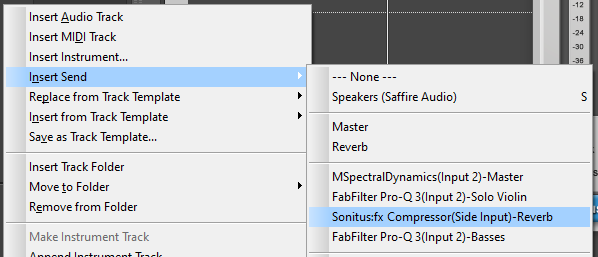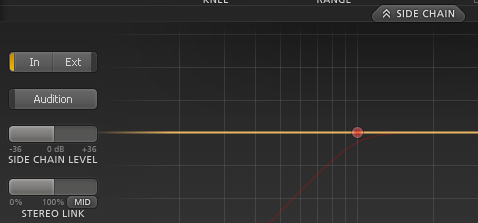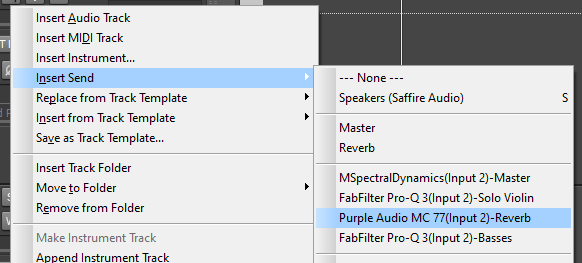-
Posts
3,370 -
Joined
-
Last visited
-
Days Won
22
Everything posted by bitflipper
-
I've never used that interface, but from what I've read it would seem that the UM2 has a built-in latency that you can't circumvent. Most audio interfaces support something called "zero-latency monitoring", aka "direct monitoring", where you're basically listening to the sound coming into the interface directly rather than running it through the computer first. The tracks you record should be perfectly in time with previously recorded tracks, because the DAW knows what the actual latency is and automatically adjusts the start time of your recorded clip accordingly. Unfortunately, I've found no information to suggest that the UM2 has that feature. You might want to think about upgrading your interface. The UM2's bigger brother, the UMC202HD has direct monitoring and is only $100. M-Audio has a similar product that supports direct monitoring that's even cheaper at $70.
-
Therein lies the crux of your error - not that you didn't have the right idea but that it was derailed by one assumption: that the sound source was immutable. Sample library developers and soft synth programmers go to a lot of trouble to introduce unpredictability, in order to make the instrument sound more natural, e.g. round robins, randomized modulations and effects. It isn't easy, given that samples are by nature static recordings and software oscillators are algorithmic. Unfortunately, such unpredictability torpedoes attempts to make objective, repeatable measurements. That's why we use test signals such as sine waves for testing, despite their being far removed from anything musical. It's about consistency, removing variables that might cause unpredictable or unreproducible results. I'd like to hear about your observations using unprocessed audio files instead of samples. You could even export the same loops you used initially and bring them back in as audio for the tests. You might well observe that the same DAW yielded different results this time! As old Joe F himself might have said: Stay Curious! Or the French equivalent, anyway.
-
Holy crap, Rain, this is getting scary. That black van is now parked in my frickin' garage! They now have access to not only my frozen zombie apocalypse stores but also to many potentially lethal gardening tools. Oh hell, now there's a light blinking on the router...I'm stubbing out this joint right now, turning out the lights and locking the doors.
-
I'm still on version 7, so mine is named "iZotope Ozone 7 Imager.dll". Starting with version 8, they stopped putting the version number in the file names, so I'd guess you're looking for the same name but without the "7". The vst3 version will be in \program files\common files\iZotope. The vst2 versions can be anywhere. Mine are under program files\cakewalk\vstplugins. Note that there are two similarly-named files for each effect in Ozone Advanced. Curiously, it's the larger of the two that is used by the main Ozone container, with much smaller files for the standalone plugins (my Imager dlls are 25MB and 3MB, respectively). The larger file (iZOzone7Imager.dll on my system) is not a VST. It gets scanned by the scanner and is included in the inventory in the register, but does not show up in the Apply Audio FX context menu because the scanner recognizes that it's not a VST. Anyway, that's about all I know concerning Ozone file names and locations. Maybe it will help turn on the proverbial light bulb.
-
Is this what the error message said? Unrecognized format? Were you using the standalone imager, or a full instance of Ozone? If you've updated Ozone since X3 days, you might just need to rescan plugins in X3. I don't remember if old Sonar had the Reset option for the scanner, but if it does I'd start with that.
-
And why I am still using Adobe Audition 3.
-
I was listening to some Tomita the other day and thinking how cool his cosmic string washes still sound 50 years later. So I decided to try to recreate them. All I knew was that he used many layers and lots of effects. What kinds of effects would have been available to him in 1973? Tape delays and reverb, basically. Maybe a chorus. So I started with various harmonically-rich sounds and began throwing anything I had on hand at them. The combination that came closest - so far - was a a low-res pipe organ (from the free Kawai N1 that someone on this forum reminded me existed) run through MVibratoMB (Rotary 4 model), Valhalla Delay (Quartz algorithm) and some reverb (FabFilter Pro-R, but others worked just as well). I layered this on top of an existing string part (Amadeus) and added volume automation to give the pipe organ a slow attack. I'm still fiddling with it, but so far it sounds very Tomita-like. Given the complex fx chain, I'm now thinking about eventually putting it into a Kontakt instrument for convenience. Still on my to-do list: try some of Omnisphere's choir patches underneath the pipe organ. All inspired by a $9 plugin I didn't need.
-
Do you get a crash dump when it happens? Or a message of any kind? What is the format of the audio you're trying to paste, e.g. wav vs. mp3? Are you bringing in the files from outside the project or copying clips within a project? Can you do the latter but not the former?
-
It was really just an installment payment option. Actual subscription plans, like the one Waves recently floated, only let you use the product as long as you keep paying.
-
Vintage Rotary excels at dirty Leslie sounds. For organ my usual go-to is IKM's Hammond, which has its own (very good) Leslie sim. But when I'm looking for raunchiness I'll turn off the IKM Leslie and use the Melda Vintage Rotary. I have also used it as a vocal effect. I picked up MVibratoMB, because for ten bucks, why not? It won't be replacing my other Leslie sims, but it'll find a use, I'm sure. The coolest thing I've done with it on so far was a bell patch with delay that serves the song as more of a percussive element than a melodic one. I made the upper mid frequencies swish from side to side, which was a pleasant effect. That led to trying it out on other higher-pitched percussion, such as the 8Dio bongos and SoundIron's bamboo ensemble. Makes them sound like the players are dancing around the room while playing. This might end up being an alternative to tired ping-pong delays.
-
Actually, *I* drive a black van with no windows. And it's parked outside my house right now!
-
Best band name I've seen suggested: 1023MB Because they haven't had a gig yet.
- 42 replies
-
- 12
-

-

-

-
You have no idea what's in the works for the coming months and years. (If I suddenly stop posting here you will know that I've already said too much.)
- 42 replies
-
- 10
-

-

-

-

-
It's inspiring to see what the pioneers did with what would today be considered minimal gear. Isao Tomita, for example, was literally the only practitioner of the synth arts in Japan, and indeed all of Asia in the early 70's. There were no YouTube videos to get him started, not even any magazines devoted to the subject. He had to teach himself everything from scratch. A true pioneer. People are still trying to figure out how he got those lush string and choir sounds. Snowflakes are Dancing (1973) still holds up today. Keep in mind this was all done on a monophonic synth with no sequencers or DAW, just magnetic tape.
-
Sure, I was still doing that too - when I was a young piker of 60. Once when my wife was out of town I stayed up all night playing video games. Now, as I approach age 72, I have to manage my energy levels the same way I monitor the fuel gauge in my car. I disassembled the PA yesterday and will be packing the van today for a gig that isn't until tomorrow. All so I can pretend to have limitless rock 'n roll energy for four hours.
-
I was contemplating on how a frisbee gets bigger as it gets closer. Then it hit me. - Steven Wright As far as the ERR_CONNECTION_REFUSED error, this is a local network problem. There are many potential reasons for it, so this is generic advice. Next time it happens try disabling your firewall. If that doesn't help, try flushing your DNS cache. I know, that second one sounds pretty nerdy. But it's quite easy to do. Open a DOS window as Administrator, then type in ipconfig /flushdns and press ENTER.
-
Am I just mis-remembering, or did Sonar not have a pitch shift feature that let you specify the shift amount in cents? I remember using the clone-and-shift technique, but don't remember using a plugin for it back then.
-
Well, they usually start the evening as adults and then regress as the night wears on. Although I am indeed an old fart, the people I entertain generally are not. Folks my age have better things to do than go out to bars. Like sleeping.
-
I play in a bar band. You have to be 21 to enter a bar. Therefore, everyone I entertain is an adult. Does that not make me an "adult entertainer"?
-
I have done that in Sonar, but it was years ago under 8.5 and I don't recall the exact steps anymore. Nowadays, I would prefer to use a plugin designed specifically for that purpose, which is much more convenient and saves having to create two extra tracks. Some plugins that do "micropitch" shifting off the top of my head... Little Alterboy by SoundToys VocalBender by Waves Micropitch from Eventide Provocative from Boz Digital Labs (recommended) ElastiquePitch by zplane There are many more, including some that are free. Google "pitch shifter". There are also a number of delays that offer pitch-shifting in the feedback loop, which creates a similar but more subtle effect. My favorite for that is tritik's tkdelay. Also note that this effect is basically what a chorus plugin does. I can get a similar result with Ubermod from Valhalla (a great plugin that should be in everybody's toolbox, imo).
-

Can anyone help me work out this sidechain technique?
bitflipper replied to kevmsmith81's topic in Cakewalk by BandLab
Some reverbs and delays have built-in ducking. One of my favorites is tkdelay from tritik. Toraverb from D16 Group is another. You don't get as much control, but it makes the process very quick and easy. Of course, this method really only works when you're using the reverb as an insert on a track rather than as a bus effect. You can also use the sidechain trick for other things. Most commonly, it's used to quickly dip a bass in synchronization with a kick drum. But you can do lots of other things. For example, route all your instruments to a bus, put the compressor there and sidechain it to the vocals. With a slow attack and release, it will subtly lower the instruments while the singer is singing. Another creative application is to put the compressor on a synth playing a pad, and modulate it off the drums so that the pad modulates in time with the drums. Once you start playing around with the technique you'll think of all kinds of novel applications. -

cakewalk: How we got here from there
bitflipper replied to Robert Hale's topic in Cakewalk by BandLab
Actually, I got the 3340S as payment for a recording session, from a friend who had bigger ambitions than his budget. So although the TEAC didn't cost me anything it did require three weeks of work. Everybody else who played on that record got cash. I got the better deal, I think. I also had a 2-track Pioneer R-R, that I scored from my employer who didn't have enough money to pay me my salary. He went out of business soon after, which is how I came to play music full time in a traveling cover band doing the Holiday Inn circuit. That led me to Lewiston, Idaho, where I met my future wife. Funny how serendipity can sometimes point the way. -

cakewalk: How we got here from there
bitflipper replied to Robert Hale's topic in Cakewalk by BandLab
In the early 70's I was an electronics enthusiast who gobbled up information from magazines such as Popular Electronics. My hobbyist shop was largely equipped with gear that I had assembled from Heathkit kits, because it was the only way I could afford them. In the process, I learned how they worked and thus began designing my own stuff. My dream at the time was to build a synthesizer. Electronics geeks quickly realized that the individual circuits used in the prohibitively-expensive Moog modular were actually pretty simple, had been around for ages, and were well-documented. I had built most of them myself, but had ongoing issues with oscillator stability - nothing I designed would stay in tune. So I was excited when a company came along called PAiA, which offered low-priced music-related electronic kits. They launched a magazine that could have been tailor-made for me, called Polyphony. It was published every other month, and nothing made my day like finding the latest issue in my mailbox. That magazine got sold to a proper publishing company and became Electronic Musician, so I subscribed to that as well. One of the founders and lead writers was Craig Anderton, a frequent contributor to this very forum. Around 1987, a brief review of a new MIDI sequencer called Cakewalk was published in EM. My eyes bugged out like a Loonytoons character when I read it. But the $300 price tag would be a major investment that my wife would probably not be enthused about. I read and re-read that review many times, imagining how cool it would be to sequence my synths with it and become a creator of electronic music like my heroes Walter Carlos, Larry Fast and king of them all, Isao Tomita. But the stars were about to align for me. I went down to LA to spend a few days training users at one of my company's customer sites, a little company in one of those nondescript industrial parks called Guitar Center. While there I hit it off with their IT guy, a guitarist who shared my interests. We became instant pals. He casually mentioned that if there was anything musical I wanted to buy that he'd get me the employee discount of cost + 10%. First thing that came to mind was Cakewalk. He went to the database and said, "how's $75 sound?". Yikes! I could manage that by eating free chicken wings at the hotel's happy hour bar and pocketing the per diem. So he took me down to their Hollywood store but nobody could find the one copy of Cakewalk they had. But he called another store and they had it. It was on the way to the airport, so I stopped there on my way out of town and left, deliriously happy, with Cakewalk 1.0. I spent the entire flight home studying the manual. I couldn't run it right away because my computer lacked a MIDI interface, so the next day I took a long lunch and picked up a $50 8-bit MIDI card. That was a Friday afternoon. By that night I had recorded my first Cakewalk project, recorded it onto my TEAC 3340S and then mixed down to a cassette. The first of innumerable evenings frittering away hours, joyously making music.- 17 replies
-
- 17
-

-

Sudden problem with performance and audio buffer
bitflipper replied to ancjava's topic in Cakewalk by BandLab
The LatencyMon test shows only that your problem is not being caused by deferred procedure calls (interrupt handlers). That's good, since such problems can be challenging to mitigate. It means something else is hogging the CPU, I/O bus or memory. Assuming you haven't developed a new hardware issue, it suggests it's software that has recently entered into service, such as a newly-installed or recently-updated utility. Start with Task Manager, or even better, Process Explorer from SysInternals. Rank processes by CPU and note anything with a high number, then rank them by memory usage and look for processes that are using large amounts of RAM. These will comprise your initial list of suspects. In your LatencyMon report, it identifies backgroundtaskhost.exe as the process with the most page faults. This is a Windows process that, as the name suggests, runs background tasks. If that's the culprit, it's not the exe itself, but something it's running in the background. Unfortunately, it's used for a bunch of Windows operations, including some that can't be turned off (e.g. Windows Updates). But it does suggest that some background process might be contributing to your laptop's running out of steam. Sorry I can't offer more specific advice. Performance analysis is a deep subject often best deferred to professional nerds. It might be worth your while to have a competent technician have a look. -

Can anyone help me work out this sidechain technique?
bitflipper replied to kevmsmith81's topic in Cakewalk by BandLab
It works with the Sonitus compressor. In fact, it's excellent for this application because of its bouncing-ball visual aid. But you do need to set the compressor's threshold, ratio, attack and release correctly to get the result you're after, which is to duck the reverb in response to the vocal so that the reverb tail ringing out from the previous vocal phrase gets turned down. Depending on your settings, this can be a subtle effect, a drastic effect, or anything in between. If you're using something other than the Sonitus compressor, it's likely you will have to explicitly tell the compressor to get its sidechain information from an external source. This isn't necessary with the Sonitus compressor. All you have to do is make sure your Send is routed to the compressor's sidechain input. TBH, I don't know how the Sonitus comp pulls this off. It must automatically disengage the internal sidechain when something is routed to its external sidechain. Most compressors I have require switching between internal to external sidechain before this technique will work. A few don't support external sidechain at all. For example, with FabFilter Pro-C you have to expand the sidechain section and click the In/Ext button to Ext. Some compressors do a good job of hiding the external sidechain switch. But if you can't find it, look at the available Send destinations because Cakewalk will know if the compressor supports external sidechaining. Note that the destination may be labeled "Input 2" instead of "Sidechain" or "Side Input".




